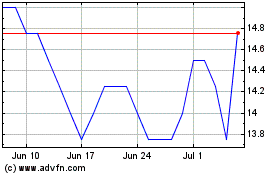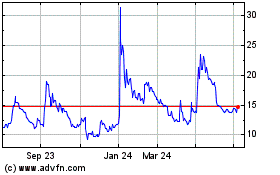TIDMAGL
RNS Number : 2138D
Angle PLC
27 January 2015
For immediate release 27 January 2015
ANGLE plc
("ANGLE" or "the Company")
PATIENT DATA SHOWS "UNPRECEDENTED SENSITIVITY AND SPECIFICITY"
FOR PARSORTIX OVARIAN CANCER CLINICAL APPLICATION
ANGLE plc (AIM: AGL OTCQX: ANPCY), the specialist medtech
company, is delighted to announce that the Medical University of
Vienna, one of its key opinion leaders, has reported highly
convincing patient data in support of the use of ANGLE's Parsortix
system in the detection of ovarian cancer.
The Medical University of Vienna will now lead, in collaboration
with ANGLE, a clinical study of the use of the Parsortix system as
a clinical application in the routine detection and treatment of
ovarian cancer patients. The multi-centre clinical study will be in
collaboration with other members of the European Network for
Translational Research in Ovarian Cancer (EUTROC) and the Tumour
Bank Ovarian Cancer Network (TOC) from Austria, Belgium, Germany
and UK. It is expected to take 18 months to complete. Assuming the
clinical study confirms the recent patient study results then ANGLE
will be able to make clinical sales of the Parsortix system to help
inform detection of ovarian cancer and clinical decision-making in
its treatment.
The patient study was undertaken under ANGLE's collaboration
agreement with the Ludwig Boltzmann Cluster 'Translational
Oncology' led by the head of the interdisciplinary Molecular
Oncology Group at the Medical University of Vienna, Professor
Robert Zeillinger. The study utilised RNA markers developed in
Vienna to analyse the cells harvested by ANGLE's Parsortix
system.
The Vienna team has worked for many years with a wide range of
CTC systems, both those commercially available from ANGLE's
competitors and new technologies under development including
commercial and academic systems. Due to lack of suitable cell
surface markers, antibody-based systems are ineffective for ovarian
cancer. The best result that has been obtained to date with other
non-antibody based systems is a CTC detection sensitivity level of
24.5% (i.e. capturing CTCs from only one quarter of ovarian cancer
patients).
Against this context, Dr Eva Obermayr, Principal Investigator at
the Medical University of Vienna describes the results with ANGLE's
Parsortix system as "sensational" and offering "unprecedented
sensitivity and specificity". The results indicated a sensitivity
of 90% for primary epithelial ovarian cancer at a specificity of
100%. Epithelial ovarian cancer (also known as ovarian carcinoma)
is the most common ovarian cancer and accounts for some 90% of
cases.
If these results are repeated in a prospective clinical study,
Professor Zeillinger believes that ANGLE's Parsortix system
together with the proprietary RNA marker panel could be adopted in
clinical practice to help inform clinical decision-making for
ovarian cancer patients in:
-- Detection of cancer in high risk or genetically pre-disposed patients (detection)
-- Monitoring therapy and selection of therapies in treatment of
ovarian cancer patients (therapy monitoring)
-- Monitoring of ovarian cancer patients in remission for early
detection of relapse (remission monitoring)
ANGLE estimates that the ovarian cancer sales potential
available for the Parsortix system in the European and United
States markets would be in excess of GBP300 million per annum.
Annually 239,000 women are diagnosed with ovarian cancer
worldwide. There is a high mortality rate and 152,000 die from it
each year. Ovarian cancer is commonly known as the silent killer
due to its lack of symptoms in its earlier stages. It is frequently
diagnosed late in which case the UK five year survival rate is only
3.5% for Stage IV and 18.6% for Stage III at diagnosis (Source:
Cancer Research UK Ovarian Cancer survival statistics). In contrast
where it is diagnosed at Stage I, the UK five year survival rates
are much higher at 90%. As a result there is an acute medical need
for improved ovarian cancer detection.
Ovarian cancer surgery is highly complex and maximal tumour
removal has a very strong impact on survival. Women with the
diagnosis or a strong indication of ovarian cancer can be referred
for surgery to specialists in gynaecologic oncology. The
consequence is a significantly better outcome compared to the
situation when surgery is performed by a general gynaecologist and
cancer is diagnosed at this point. There would therefore be great
clinical benefit if it were possible to know in advance of surgery
if an abnormal pelvic mass is malignant.
A common approach is to use a blood test for the biomarker
CA-125 for detection of epithelial ovarian cancer, either alone or
in combination with another marker HE4. However the quoted
sensitivity for CA-125 is only 63% (i.e. 37% of cancers are missed
as false negatives) and as a result it is not considered
effective.
Vermillion, a US Nasdaq listed company, has developed OVA1, an
alternative epithelial ovarian cancer test that integrates
biomarker measurement in blood and a software algorithm, which is
FDA authorised and the company is now beginning to commercialise.
The Medicare reimbursement level for OVA1 is $516. The company
estimate that, in the United States alone, there are some 200,000
patients with abnormal pelvic masses where surgery is undertaken,
which may be investigated with OVA1 (of which 22,000 will have
ovarian cancer) suggesting a United States market for a specific
segment of the larger detection market of in excess of $100m per
annum. There is a substantially larger patient population in the
United States of some 750,000 per annum if all abnormal pelvic
masses are investigated. Vermillion quotes a sensitivity of 93% and
specificity of 43% for OVA1 and indicates that this is a
considerable improvement over CA-125.
If the clinical study confirms the patient data announced today
then ANGLE's Parsortix system has the potential to substantially
out-perform the current standard of care in ovarian cancer,
particularly in relation to specificity (i.e. if a person does not
have the disease how often will the test be negative).
The group at the Medical University of Vienna believes that the
exceptionally good results with the Parsortix system are explained
by the high purity of the Parsortix harvest (very low numbers of
leukocytes) combined with the sensitivity of their RNA markers.
Professor Robert Zeillinger, Head of the Molecular Oncology
Group at the Medical University of Vienna, commented:
"Using ANGLE's Parsortix system with a panel of ovarian
carcinoma-specific RNA markers, we were able to detect and analyse
CTCs in 90% of patient samples at a specificity of 100%. This is an
unprecedented test performance and we will be immediately moving to
a clinical study to validate the use of this system in the
detection and treatment of ovarian cancer patients. We will also be
preparing a high impact publication on these results for discussion
with our colleagues in ovarian cancer worldwide."
ANGLE Founder and Chief Executive, Andrew Newland,
commented:
"These are highly encouraging results for the use of the
Parsortix system. There is a very strong medical need in ovarian
cancer for earlier detection and monitoring of patients and we hope
our Parsortix system will be able to really make a difference.
Commercially ovarian cancer is a substantial but tightly defined
market where there is little competition. It is an ideal first
clinical market for ANGLE to progress. We will be focusing our
resources to deliver this opportunity as quickly as possible.
Today's announcement marks the start of ANGLE moving into the
clinical phase."
For further information:
ANGLE plc 01483 685830
Andrew Newland, Chief Executive
Ian Griffiths, Finance Director
Cenkos Securities
Stephen Keys, Dr Christopher
Golden (Nominated adviser)
Andy Roberts (Sales) 020 7397 8900
Buchanan
Mark Court, Sophie Cowles 020 7466 5000
For Frequently Used Terms, please see the Company's website on
http://www.angleplc.com/the-parsortix-system/glossary/
Notes for editors
About ANGLE plc www.angleplc.com
ANGLE is a specialist medtech company commercialising a
disruptive platform technology that can capture cells circulating
in blood, such as cancer cells, even when they are as rare in
number as one cell in one billion blood cells, and harvest the
cells for analysis.
ANGLE's cell separation technology is called the Parsortix
system and it enables a liquid biopsy (simple blood test) to be
used to provide the cells of interest. Parsortix is the subject of
two granted US patents and three extensive families of patents
being progressed worldwide. The system is based on a microfluidic
device that captures cells based on a combination of their size and
compressibility. The Parsortix system is established with strong
positive evaluations from leading cancer research centres and is
working with these cancer centres to demonstrate key applications.
Parsortix has a CE Mark for Europe and FDA authorisation is in
process for the US.
The analysis of the cells that can be harvested from patient
blood with ANGLE's Parsortix system has the potential to help
deliver personalised cancer care offering profound improvements in
clinical and health economic outcomes in the treatment and
diagnosis of various forms of cancer.
The increase in cancer to a 1 in 3 lifetime incidence is set to
drive a multi $billion clinical market. The Parsortix system is
designed to be compatible with existing major medtech analytical
platforms and to act as a companion diagnostic for major pharma in
helping to identify patients that will benefit from a particular
drug and then monitoring the drug's effectiveness.
Now that the Parsortix system has been developed, ANGLE is
focused on its commercialisation in the market.
ANGLE has established formal collaborations with world-class
cancer centres and is working with these cancer centres to
demonstrate key applications for its Parsortix non-invasive cancer
diagnostic system as a liquid biopsy. Details are available here
http://www.angleplc.com/the-company/collaborators/
As well as cancer, the Parsortix technology has the potential
for deployment with several other important cell types in the
future.
ANGLE began trading on the AIM market of the London Stock
Exchange in March 2004 under the ticker symbol AGL. For further
information please visit: www.angleplc.com.
This information is provided by RNS
The company news service from the London Stock Exchange
END
MSCLIFSRLLIDFIE
Angle (LSE:AGL)
Historical Stock Chart
From Mar 2024 to Apr 2024

Angle (LSE:AGL)
Historical Stock Chart
From Apr 2023 to Apr 2024
